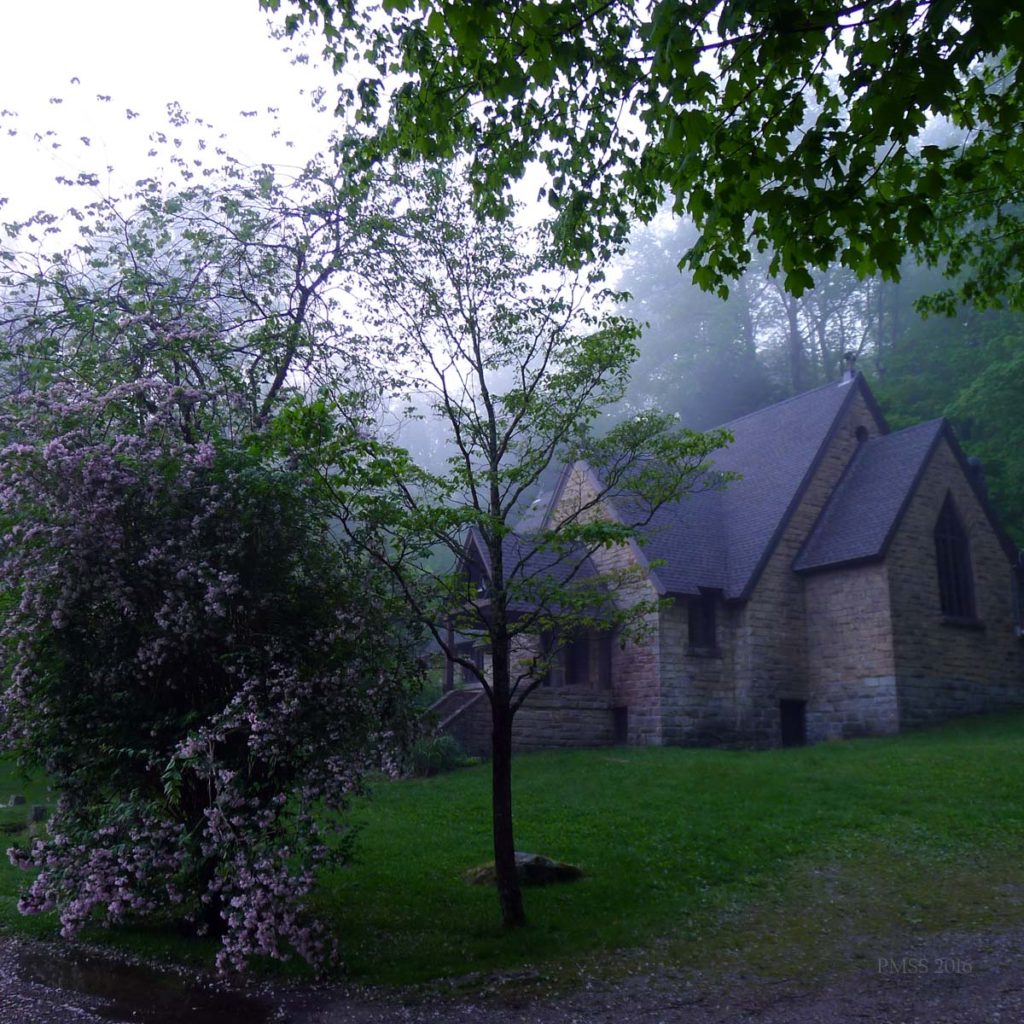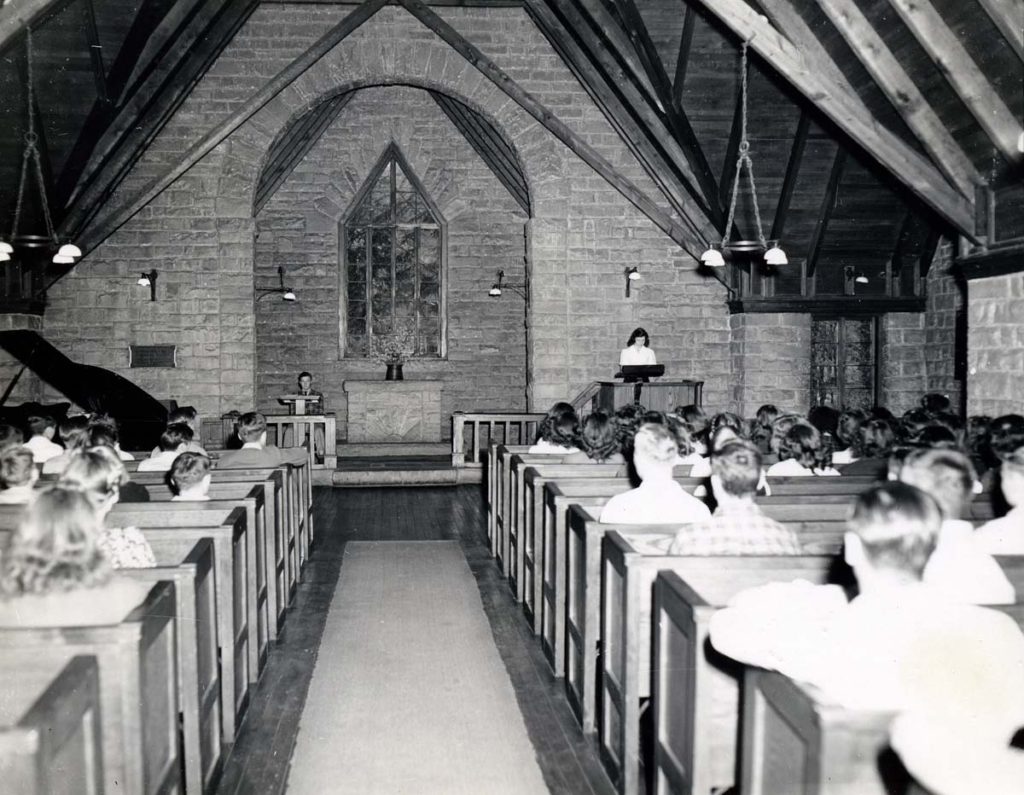Pine Mountain Settlement School
Series 34: RELIGION
Religion at PMSS
Overview and History

Chapel, early morning. Photo by hhw. [P1130863-1.jpg]
TAGS: Religion, non-sectarian, religious service, Presbyterians, Methodists, Catholics, Episcopalians, Christians, religious life at PMSS, Ethel de Long Zande, Katherine Pettit, Pine Mountain Settlement School, Evelyn K. Wells, Nativity Play, Christmas, Vespers
RELIGION
RELIGION AT PMSS
Evelyn K. Wells in her HISTORY OF PINE MOUNTAIN SCHOOL describes religious life at Pine Mountain from 1913 to 1928. She notes that religious life at the School at that time was conceived as “Christian, but non-sectarian.” Wells drew this description of religious life at the School from the first subscription cards issued by the School in 1913 that described the institution in this manner. Religion has always been a part of the earliest mission of the institution all the while staying the course of this Christian but a non-sectarian path through most of its one-hundred-year-plus history.
The reflections of Evelyn Wells are important to share at length as she captures and builds her description of religious life at the School as it was being shaped and formed by the founders. The importance of the Wells description is the persistence of her overview of the institution while being a part of its early history. Religious life at the School as it was practiced by the early administrators and the staff who worked there, is full of deeply moving stories of self-discovery but also the discovery of serving others through a non-sectarian perspective. Wells, in her description of the religious life at the School during the Boarding School years says
In a country riven by denominational feeling and even inter-denominational feeling, where theology has never been related to a Christianity that was in daily practice, the School has tried to lay a foundation of religious ideals in the children’s lives that would help them work and live with others, regardless of church membership. At the dedication of the second Mary Sinclair Burkham Schoolhouse, Mrs. [Ethel de Long] Zande, in speaking [to the children gathered for the service] of the installation of the corner-stone [said]
“Now, every time you come into this building, you will see it and remember that this building is in memory of someone who thought of others. And as you remember this, you must remember that you are having the opportunity of learning to think, because there was someone who didn’t think only of herself all the time, but who thought of making her life count for somebody else too.
You must remember that you have responsibilities too. You must make your lives count for others. Do you know that once, when the people in Harlan County were giving money for the road [Laden Trail] there was a man who wouldn’t give a single dollar? They told me he was the richest man in the county, he had fine clothing on and looked prosperous, but he couldn’t give to something if it wasn’t for his own benefit. That man hasn’t made a success of his life. Here at Pine Mountain, we don’t think anyone is successful in life if he hasn’t made it count for somebody else. I want you to think of this every time you see this stone [Dedication stone[s]. If you are rich, and wise, and healthy, and there are poor and ignorant, and weakly, if you don’t help them, you are not living up to the teachings of this school.”
The Dedication Stones of Burkham School House I were built into the new Burkham School House II and when it burned, the stones were displayed at the location of the second destroyed education building.
HONESTY SELF-RELIANCE TRUTH HUMANITY, SELF-CONTROL
RELIGION AT PMSS: Unique Services
Religion at Pine Mountain was often referred to as best reflected in good work under the guidance of the Dedication Stones. Yet, the rituals of familiar religious service were also practiced at many events but often in a unique and non-denominational manner. The Christmas Nativity Play, Thanksgiving, a hiking trip to Jack’s Gap where St. Francis’ Canticle of the Sun was read — “beautiful and simple” describes many of the services at the School, always reflective of a religion that constantly found inspiration in the beauty of God’s work, the beauty of His word, and the beauty present in the place that is Pine Mountain Settlement School.
The Chapel has always been a center of education and for more formal religious services such as Vesper services where staff, during the Boarding School days, would prepare and present a talk on a variety of topics. Attendance was voluntary. Evelyn K. Wells calls our attention to Ethel de Long Zande in her history of the School and describes Zande’s talks as “vivid illustrations and warm and living Christianity.” The talks, said Wells, of Ethel de Long Zande’s “talks”, were always related in some manner to the lives of the children she served to educate in her short life.

Interior of the Chapel. [ii_chapel_0360d.jpg]
The Children have never been encouraged to think that the verbal profession of Christ was important at this stage of their lives, rather, we have been confident that the seeds should be laid and left to germinate, that permanent good developed slowly. It has often been difficult for us to persuade visiting preachers that what seemed to them a golden opportunity to urge a promising group of young people to make a public confession, should not be seized. Once or twice, however, there has been baptizing here. In April 1922, twenty-one boys and girls were baptized into “the church universal,” mature young people who when the chance came to them, would enroll in the church of their choice.
… The dignity of all our chapel services, their restraint and order, and sincerity, has had its own lesson for children of this order and sincerity, [and] has had its own lesson for children of this country, where church meeting has been social rather than uplifting.
RELIGION AT PMSS: Through the Years
This early observation by staff member and Trustee, Evelyn Wells, of the religious life at the School has been filtered differently down through the years. As new Directors of the School have come and gone, religious life has often changed its focus, but all the while it has remained largely non-sectarian. In later years, however, while the School maintained a non-sectarian stance, it adopted many elements of sectarian religious practice, common to the communities it sought to serve.
Some of the Directors were graduates of theological schools, such as Glyn Morris, and H.R.S. Benjamin. Morris, whose training at Union Theological School in New York was guided by his progressive views of social justice was strongly influenced by Reinhold Niebuhr, a noted theologian and philosopher. As Wells indicates in her early narrative, many preachers of various denominations visited the School and introduced diverse ways to express a Christian life.
Many Directors had participated in prior work associated with sectarian religious practice or social services associated with various religious associations. These associations often influenced their tenure as Directors at the School. While they introduced elements of their prior religious association or belief system in their administration, few attempted a unilateral position or mandated specific religious beliefs in their hiring practices or in their educational programming.
Prayer before meals was common throughout the boarding school days and was often sung by the students as a series of rounds. House prayer services were often held with the children dependent upon the interests of the housemothers or the students. Generally, while children were boarding at the School in the early years, they were required to attend church and Sunday school services which often varied in their offerings and were largely non-sectarian. During 1922-23 a Methodist minister from Harlan was a regular monthly visitor. Berea also often sent ministers to the School who held both formal services and informal meetings with students and staff centered on a variety of religious topics, including overviews of Appalachian religious practices and World religions. Yet, while there have been strong outside influences and periods of intense sectarian activity at the School, the atmosphere has generally been one of tolerance for the religion of others and an unwavering personal dedication of service to others.
**********
To read more about religious life at Pine Mountain School and in the community, and to explore some of the personally held religious beliefs of the School staff and students, follow the links in:
RELIGION Guide
Includes Chapel, Vespers, Programs, Community Religions,
Weddings, Funerals, Funeralizings, Preachers, etc.
See Also:
RELIGION A Mountain Funeralizing
RELIGION Statements of Belief at Pine Mountain Settlement School
RELIGION Student Reflections on Religion at PMSS
RELIGION Vespers Service William Hayes c. 1942 (WW II)
VESPERS Services
Wells Record 18 PMSS Religious Life 1913-1928
CELIA CATHCART “A Funeralizing on Robber’s Creek”
EVENTS CHRISTMAS at Pine Mountain Settlement School GUIDE
GLYN MORRIS 1940 General Statement of History and Philosophy of PMSS for Staff
GLYN MORRIS 1941 Religion in the Mountains
RELIGION PMSS Records of Church Membership Baptisms Weddings I
RELIGION PMSS Records of Church Membership Baptisms Weddings II

